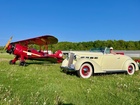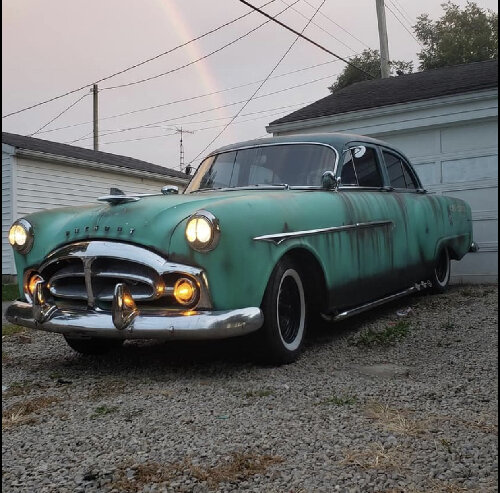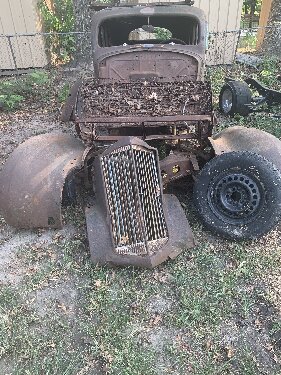|
Re: V-8 head part nbr vs cast nbr
|
||||
|---|---|---|---|---|
|
Home away from home

|
OK, I've got a half-dozen 374"s so I should be able to find one on which the head casting number is readable. I'll be going up to my shop where they are stored later this week.
Let's start over on the 320" heads: 1. Were the machined 320" heads a different casting number than that of the 352"? It would have been relatively easy operation to make the machined combustion chamber 8cc larger. The as-cast chamber is what it is. 2. Has anyone seen any info to indicate when the 320" change was made to as-cast, did the valve size and/or compression ratio also change? That it was necessary to change the carburetor and distributor may have been necessary due to a higher compression ratio. Why else change those components? 3. Does anyone have a set of as-cast 320" heads. It would be interesting to check the CCs to determine if they are different from the machined heads. As to why the change from machined to as-cast combustion chambers: 1. I doubt it was for cost savings. Machining was a simple one-pass with an end mill. It was more costly to change the pattern, pour the test castings and make the checks and remove the machining operation from the line than to leave it in place. 2. My opinion is it was the easiest way to raise the compression ratio. They just made the chamber smaller by changing the pattern to add more iron. 3. The smaller chamber also slightly shrouded the valves. This is probably why the change to 2" intakes. Now that we're getting some traction on head casting and part numbers, how about crankshafts? In theory, with three different bore diameters and piston weights, there should be three different part numbers. Then there's the Unobtanium forged crankshafts, so six part numbers. I've never seen a casting number, forging number or part number visible on any Packard V8 crankshaft. How do we know what we should have, much less what we've got? thnx, jack vines
Posted on: 2008/9/17 14:07
|
|||
|
||||
|
Re: V-8 head part nbr vs cast nbr
|
||||
|---|---|---|---|---|
|
Home away from home

|
Interesting and arcane info. I've never worked on 320" heads, but by my calculations, they should have 8cc smaller combustion chambers than the '55 352" heads if both have the same 8.5 compression ratio. The Hash engines with the 352" heads on the 320" short block had 7.8 C.R., so that also mathematically checks backward.
Questions: 1. What was the date of the service letter announcing the change from machined to cast combustion chambers? I had assumed the change was made to raise the compression ratio for '56. If so, why was the change made on the 320" engine which never had a published C.R. increase? 2. Did the service letter specifically state the change was only for 320"? All later 352" and 374" had cast chambers, but why would they only announce it for 320"? 3. Was the switch to 2" intakes made at the same time? The specs for all '55s I have seen in print are for the smaller valves, but has anyone ever seen a machined chamber with the larger valves or a cast chamber with the smaller valves? 4. Since '55 352"s had 8.5 C.R and the '56s had 9.55 C.R. (the '56 Hashes got the 9.55 C.R., but still only the two-barrel carburetor.) was the cast chamber phased in at model year change for 352"? thnx, jack vines
Posted on: 2008/9/17 10:43
|
|||
|
||||
|
Re: engine guys...Valve seals?
|
||||
|---|---|---|---|---|
|
Home away from home

|
Hi, Mike,
Valve stem seals are unlikely to be your big problem. A valve stem seal oil burning doesn't come and go. Smoke from a missing valve stem seal will be present a bit upon deceleration and a lot upon acceleration after a decel. Closing the throttle at speed creates a very high vacuum. Oil is sucked past the valve guides. Opening the throttle, the cylinders are coated with oil and it burns and smoke is visible. Missing seals will smoke a bit on steady high-vacuum cruise. 1. Is the smoke definitely blue? Black smoke can be a stuck choke, stuck carburetor float, ignition problems. 2. If the smoke is definitely blue, there are only two ways for oil to get into a stock Packard: a. Valve stem seals, but this symptom doesn't get worse and better randomly. b. Something mechanical, such as stuck/broken rings, cracked piston. 3. A few Packards from California had PCV valves installed on the. Often this was not done correctly. Often, it was not maintained. Check for any vacuum line going into the intake manifold. This includes a power brake system. Not common on Packards, but one owner of another brand was chasing an oil burning problem while his brake fluid was going out the tailpipe. 4. Head gasket. When a head gasket fails, at high temps antifreeze can be sucked into the chamber and whiter smoke insues. Check the coolant level. thnx, jack vines
Posted on: 2008/9/15 10:26
|
|||
|
||||
|
Re: would this supercharger fit my clipper 352cid
|
||||
|---|---|---|---|---|
|
Home away from home

|
Yes, No, Maybe:
Yes, it can be done. No, you probably shouldn't do it. Maybe, just for the wow factor and being able to say it came off a "Packard" engine (which everyone knows was a Studebaker.) The McCulloch is pretty small to make real boost on a 352". Figure you will get 2-3 PSI at most. By the time you fab the brackets and pulleys, get a new carb bonnet for a 4-bbl, re-jet the carb, re-curve the distributor, re-plumb the fuel pump, and finally spend $500 to rebuild the supercharger, you might get another 25-35 horsepower out of it. thnx, jack vines
Posted on: 2008/9/1 23:45
|
|||
|
||||
|
Re: 1955 Packard Truck V8 in 2008
|
||||
|---|---|---|---|---|
|
Home away from home

|
AFAIK, Studebaker never made a panel truck. From '49-59 the C-cab pickups came in 1/2t, 3/4t and 1t. The 1/2t came in 112" wheelbase and a 6.5' box and 122" wheel base with an 8' box. The 1t could be had with a 8' box, 9'box or a flat bed. Because of a dealer franchise deal, Studebaker labled a very few trucks as Packards and sent them to South America, but they were Stude in everything other than nameplate.
My truck is a 3/4t, 122" wheelbase, 8' box, 6-lug Budd wheels, Spicer rear axle. thnx, jack vines
Posted on: 2008/8/28 22:47
|
|||
|
||||
|
Re: 1955 Packard Truck V8 in 2008
|
||||
|---|---|---|---|---|
|
Home away from home

|
Why assume a 1" shaft? Double the length of the OEM bearing area within the housing and add a bearing in the bottom plate.
thnx, jack vines
Posted on: 2008/8/28 21:37
|
|||
|
||||
|
Re: New Guy Introcuction.
|
||||
|---|---|---|---|---|
|
Home away from home

|
Hi, Kevin,
Understand completely. Have him call or e-mail me if there is anything I can do to help. Anything which gets a Packard V8 into national attention is good for us all. thnx, jack vines
Posted on: 2008/8/28 15:11
|
|||
|
||||
|
Re: New Guy Introcuction.
|
||||
|---|---|---|---|---|
|
Home away from home

|
Greetings, Kevin,
Great to hear from you! I had the pleasure of meeting you and visiting your shop a few months back. I can attest you and your guys do premium quality work on classic hot rods. The owner-to-be of this proposed build called me earlier this week to talk Packard V8s. FWIW, I sold Rich Fox the NOS Iskenderian cam he had reground by Deema Elgin to run in his Bonneville Vega. I've got two '56 Caribbean 374"s in the works and can help with anything up to and including a turnkey engine. Just check in with me, PackardV8@comcast.net. Jack Vines Studebaker-Packard V8 Limited Spokane, WA
Posted on: 2008/8/28 14:20
|
|||
|
||||
|
1955 Packard Truck V8 in 2008
|
||||
|---|---|---|---|---|
|
Home away from home

|
Greetings, Packard V8s,
For many Studebaker-Packard adherents, it has been a subject of some discussion as to how Studebaker should have offered the Packard V8 in Studebaker trucks. There could even have been a deluxe variant Packard truck, a la the Packard Hawk. To investigate what this might have looked like, I'm building a Packard V8 to go in my 1955 Studebaker E12 3/4t truck. For the first iteration externally it will look as if it all came from the S-P parts bins. Later, I may consider adding EFI and crank-triggered ignition. 1. 1955 Packard 352" bored to 4.070" for 364" (no misprint). 2. 1979-91 Ford 370" heavy-duty truck pistons with a cast iron top groove insert and a D-shaped dish. These pistons w/pins weigh 173 grams more than a standard Packard 352" piston w/pin. They have to have .050" taken off the top and .1875" off inside each pin boss. 3. Packard V8 connecting rods, pin bushings pressed out and pin bores honed for Ford 1.040" pressed pins. Rods have been extensively machined on a lathe and hand ground to remove 72 grams of weight. 4. 1968 Ford 428" 41# steel billet flywheel with center hole enlarged and drilled to Packard bolt circle, modified to mount Packard ring gear. 5. Packard v8 camshaft reground to contemporary truck specifications for a flat torque curve from 1000-4000 RPMs. Jones Cam Designs Part# H62279-112 248/248 @ .006" 227/227 @ .020" 192/192 @ .050" .279"/.279" Lobe Lift 112 LSA 7. Custom-built oil pump with three times the bearing area of the OEM pump, 1/2" thick cast iron bottom plate, and the second-design cam retainer plate and spacer. 8. A custom five-speed transmission, built from a 1964 Studebaker GT Hawk Borg-Warner T10 four-speed with a 1956 Borg-Warner R11 overdrive unit. 9. The one visible non-stock part will be a Dodge Viper two-speed electric fan. The C-cab doesn't have much sound insulation and the stock fan is just too noisy at highway cruise. This will be inside the OEM fan shroud and won't be too noticeable. 10. 1955 heads matching the D-dish in the pistons, milled on three sides, new valves, new springs, second-design hardened retainers, new lifters, rocker tips reground, rocker shafts brush cleaned. 11. Completely static and dynamic balanced, including front damper, flywheel and pressure plate.. The parts are all in hand, crankshaft reground .010" mains-.020" rods, rods machined and block been cleaned, ready to be bored, decked, line honed and assembly should begin in a week or two. thnx, jack vines
Posted on: 2008/8/27 15:56
|
|||
|
||||








